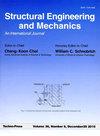Investigating the effects of span arrangements on DDBD-designed RC buildings under the skew seismic attack
IF 2.2
4区 工程技术
Q2 ENGINEERING, CIVIL
引用次数: 0
Abstract
This paper focuses on examining the effects of span arrangements on displacement responses of plan-symmetric RC frame buildings designed using the direct displacement-based design (DDBD) method by employing non-linear analyses and the skew seismic attack. In order to show the desired performance of DDBD design approach, the force-based design approach is also used to examine the seismic performance of the selected structures. To realize this objective, 8-story buildings with different plans are selected. In addition, the dynamic behavior of the structures is evaluated by selecting 3, 7, and 12-story buildings. In order to perform non-linear analyses, OpenSees software is used for modeling buildings. Results of an experimental model are used to validate the analytical model implemented in OpenSees. The results of non-linear static and non-linear dynamic analyses indicate that changing span arrangements does not affect estimating the responses of structures designed using the DDBD approach, and the results are more or less the same. Next, in order to apply the earthquake in non-principle directions, DDBD structures, designed for one-way performance, are designed again for two-way performance. Time history analyses are performed under a set of artificial acceleration pairs, applied to structures at different angles. It is found that the mean maximum responses of earthquakes at all angles have very good agreement with the design-acceptable limits, while the response of buildings along the height direction has a relatively acceptable and uniform distribution. Meanwhile, changes in the span arrangements did not have a significant effect on displacement responses.探讨了在斜交地震作用下,跨度布置对ddbd设计的钢筋混凝土建筑的影响
本文通过非线性分析和斜震攻击,研究了采用直接基于位移的设计(DDBD)方法设计的平面对称钢筋混凝土框架结构的跨距布置对其位移响应的影响。为了显示DDBD设计方法的预期性能,还采用了基于力的设计方法来检查所选结构的抗震性能。为了实现这一目标,选择了不同平面的8层建筑。此外,通过选择3层、7层和12层的建筑来评估结构的动力性能。为了进行非线性分析,使用OpenSees软件对建筑物进行建模。实验模型的结果用于验证在OpenSees中实现的分析模型。非线性静力分析和非线性动力分析的结果表明,改变跨度布置对采用DDBD方法设计的结构的响应估计没有影响,而且结果大致相同。其次,为了在非主方向上应用地震,将设计为单向性能的DDBD结构重新设计为双向性能。在一组人工加速度对作用于不同角度的结构下进行时程分析。结果表明,各角度地震反应均值与设计可接受极限吻合较好,建筑物沿高度方向地震反应均值分布较均匀。同时,跨度布置的变化对位移响应没有显著影响。
本文章由计算机程序翻译,如有差异,请以英文原文为准。
求助全文
约1分钟内获得全文
求助全文
来源期刊

Structural Engineering and Mechanics
工程技术-工程:机械
CiteScore
3.80
自引率
18.20%
发文量
0
审稿时长
11 months
期刊介绍:
The STRUCTURAL ENGINEERING AND MECHANICS, An International Journal, aims at: providing a major publication channel for structural engineering, wider distribution at more affordable subscription rates; faster reviewing and publication for manuscripts submitted; and a broad scope for wider participation.
The main subject of the Journal is structural engineering concerned with aspects of mechanics. Areas covered by the Journal include:
- Structural Mechanics
- Design of Civil, Building and Mechanical Structures
- Structural Optimization and Controls
- Structural Safety and Reliability
- New Structural Materials and Applications
- Effects of Wind, Earthquake and Wave Loadings on Structures
- Fluid-Structure and Soil-Structure Interactions
- AI Application and Expert Systems in Structural Engineering. Submission of papers from practicing engineers is particularly encouraged.
 求助内容:
求助内容: 应助结果提醒方式:
应助结果提醒方式:


